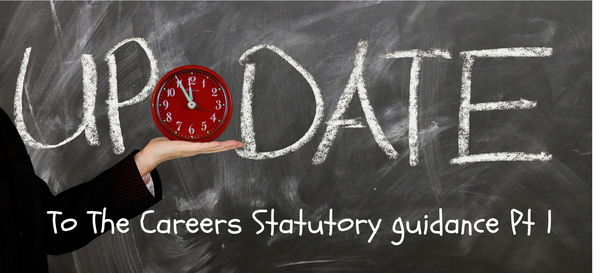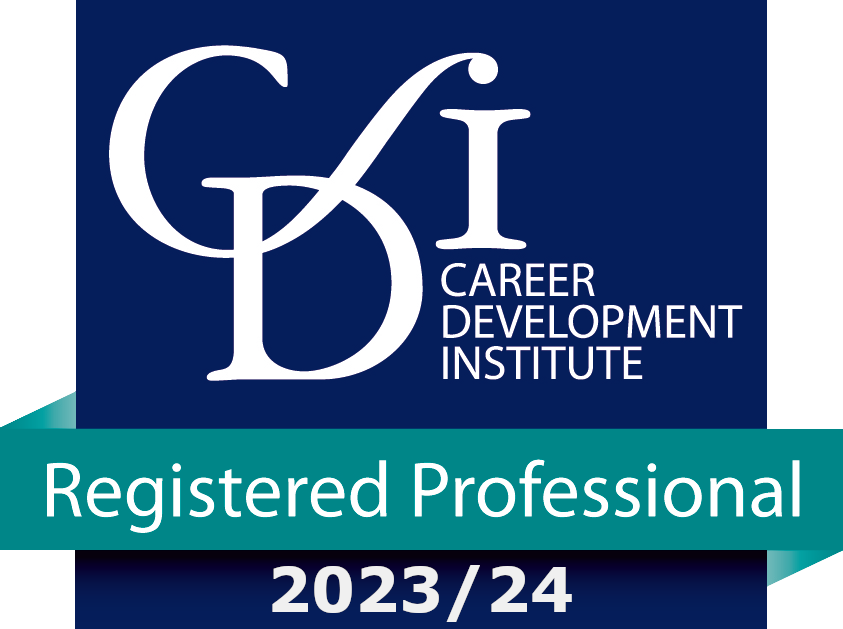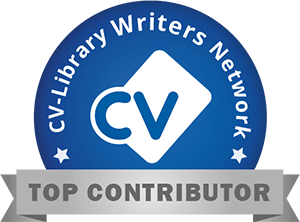CEIAG & Careers Leaders
- What every SLT and Careers Leader needs to know about new statutory guidance for careers January 2023 Part 1

What every SLT and Careers Leader needs to know about new statutory guidance for careers January 2023 Part 1
Friday 6th January 2023
Happy new year, (The next sentence is to be read in irony mode) I hadn't intended to go back to work properly until 9th January but those so and sos at the DFE have published the updated statutory guidance that is now in effect. (Back to serious mode)
Now the CEC have done a good job publishing support over the past few months, I presume that they have an inside track from the DFE so are well ahead of everyone else so if you've not been keeping up with the CEC output on the provider access legislation, I suggest you give it some attention.... NO not now, AFTER you've read my blog
So what are the differences?
Well firstly there are a number of new sections in the index which signpost what is to come further on in the document. Which is a clearer explanation of what is expected of schools and colleges and adds an undertaking that the guidance will be reviewed yearly and amended if it needs an update.. It also clearly signals the role of the Careers and Enterprise Company (CEC) and signals the use of the term Provider Access Legislation (PAL) rather than the informal term Baker Clause.
- Page 6/7 details the legislative requirement which came into effect at the start of 2023 and goes on to say they've put in a 'ladder of support' and clarified the role of careers in middle schools. It also clearly states that the funding of these duties falls to the schools' funding arrangements.
Through the Skills and Post-16 Act 2022, the government has strengthened this legislation by introducing a minimum number of six provider encounters that every school must provide and, for the first time, introduces parameters around the duration and content of these encounters so that we can ensure they are of high quality.
The Gatsby Benchmarks
On page 10 It quotes CEC figures that now schools meet an average 4.9 out of 8 of the Gatsby Benchmarks as against 1.87 when the CEC came into existence. It's VERY clear that secondary schools are expected to continue to strive towards meeting all 8.
Benchmark 1 is outlined on page 17 - 19 providing a stable careers programme, highlights the positive impact of schools that are in a careers hub and requires
- A structured stable programme with the EXPLICIT backing of SLT
- An explicit and appropriately trained careers leader
- The careers programme to be published on the schools website in a form that is accessible for all interested parties.
- Regular evaluation of the programme by all interested parties.
Benchmark 2 page 20-22 Learning from career and Labour Market Information (LMI)
- All pupils by the age of 14 to have accessed Labour Market Information (LMI) and information on career paths in order to inform future study options. Bullet point 2 then says all pupils should be accessing this information during their study programmes
- Parents should be encouraged to access and use LMI and info on career paths in order to support their children
It also highlights the Get the Jump resource from the National Careers Service (NCS) as well as continuing to highlight LMI for all, Discover Uni and a few other resources.
Benchmark 3 pages 22-27 Meeting the needs of all pupils adds Gypsy, Roma and Traveller backgrounds to the list of vulnerable groups and requires:-
- Challenge stereotypical thinking and raise aspirations
- Schools to keep individual records of advice given to each pupil and the decisions agreed. Pupils should have access to these records
- Records should be integrated into those from a previous stage of their education
- Destinations data in schools needs to be collected for at least 3 years after they leave your school. (Colleges should collect and maintain accurate data for each student on their education, training or employment destinations.)
Benchmark 4 page 28/9 Linking careers to the curriculum is much unchanged but still requires
- By the age of 14, every pupil should have had the opportunity to learn how the different STEM subjects help people to gain entry to, and be more effective workers within, a wide range of careers.
- Throughout their programme of study (and by the end of their course) every student should have had the opportunity to experience how their subjects help people gain entry to (and be more effective workers within) a wide range of occupations
Benchmark 5 pages 30-32 Encounters with employees and employers Highlights the role of T Levels and support that has been put into place and in a footnote on page 31 what an meaningful encounter is
A ‘meaningful encounter’ is one in which the student has the opportunity to learn about what work is like or what it takes to be successful in the workplace.
- Requires one meaningful encounter with an employer per school year.
- Alongside their study programme pupils in college should have 2 encounters each year with an employer at least one as part of their study programme
- Colleges should record and take note of pupils own employment and the influence this has on their choices.
Benchmark 6 pages 33-35 Experience of workplace adds nothing new to the previous list of examples of experience of the workplace but is essential reading if you've not gone through this before.
- By the age of 16, every pupil should have had at least one experience of a workplace, additional to any part-time jobs they may have.
- By the age of 18, or before the end of their study programme, every student should have had at least one further experience of a workplace, additional to any part-time jobs they may have.
Benchmark 7 pages 36-38 Encounters with FE and HE
- By the age of 16, every student should have had a meaningful encounter with providers of the full range of educational opportunities, including sixth forms, colleges, universities and apprenticeship providers. This should include the opportunity to meet both staff and students.
- Two visits to universities for those considering the university route by the age of 18
- By the age of 18 or before the end of their programme of study a meaningful encounter with both staff and students of FE & HE colleges, apprenticeship and training providers as appropriate.
Benchmark 8 pages 39/40 Personal guidance outlines a lot of good resources that support the commissioning and role of personal guidance and sets out in a footnote that
The school or college should ensure that access to an adviser trained to level 6 in a career development subject is available when needed.
- Every student should have opportunities for guidance interviews with a career adviser, who could be internal (a member of school or college staff) or external, provided they are trained to an appropriate level. These should be available for all students whenever significant study or career choices are being made. They should be expected for all students but should be timed to meet their individual needs.
- Every pupil should have at least one such interview by the age of 16 and a further interview should offered by the age of 18
The role of Governors
On page 14/15 The role of governors, of schools, is clearly set out as being responsible for ensuring that the schools meet the requirements of the updated statutory guidance and we are informed that the CEC has produced Guidance for Middle Schools, which will help Middle Schools understand their requirements and how best to achieve the Gatsby Benchmarks.
Ladder of support
Page 15 also goes on to point out that the DFE has evidence of schools not meeting the requirements of the Provider Access Legislation and points us towards their 'ladder of support' which is highlighted on pages 51-54
- CEC resource directory
- Career Hubs
- Additional support provided by the CEC and/orr DFE which can be triggered by a complaint or an Ofsted inspection finding that the PAL isn't being met.
In schools, the governing body must also make sure that arrangements are in place to allow a range of education and training providers to access all students in years 8 to 13 to inform them about approved technical education qualifications and apprenticeships, and that a policy statement setting out these arrangements is published (the legal requirements of the provider access legislation). Following the changes to the duty, the governing body must ensure schools comply with the minimum requirements (page 42). This should be part of a broader approach to ensuring that students are aware of the full range of academic and technical routes available to them at each transition point.
Information for all staff on skills and technical education reforms
This is quite a weighty block of information but basically breaks down into ensuring that staff have a thorough understanding of the changes in education and qualifications that have happened over the past few years. Main points follow
- Schools must act impartially and set pupils towards a path that will secure the best outcome for the pupil.
- Technical qualifications such as HTQs, TLevels, apprenticeships, traineeships and supported internships are amongst the range of opportunities what are available for pupils.
- There is much evidence of the importance and efficacy of provider encounters and this is set out on page 42
- There must be six encounters with a provider of apprenticeships or technical education for year 8-13 pupils These should be delivered in a timely way to inform choices at 13,16 and 18 i.e 2 each in KS3,4 and 5 These encounters are mandatory for all pupils to attend in KS3 and 4 whilst pupils are free to opt out of the KS5 encounter the school must still provide it.
- All encounters must happen for a reasonable length of time during the school day.
- All encounters with providers should give
• information about the provider and the approved technical education qualifications or apprenticeships that the provider offers,
• information about the careers to which those technical education qualifications
or apprenticeships might lead,
• a description of what learning or training with the provider is like,
• responses to questions from the pupils about the provider or approved technical education qualifications and apprenticeships.
- The six encounters are a minimum standard and schools are free to provide more if they wish and are able to.
- Schools should identify providers which are within a reasonable travelling distance to their school
- Page 44-46 lists types of providers you may wish to include.
- Attention should be given to the timing of such encounters and the aim should be to develop a firm understanding of the type of options available to pupils at different stages of their career.
- Schools should not do anything to restrict attendance at sessions, e.g. restrict invitation or provide opportunities outside school hours.
- Providers can bring appropriate representatives with them e.g. employers or indeed ask them to wholy represent the provider. Schools cannot reasonably refuse this request.
- Schools should NOT require a DBS for a one off visit but should decide on the appropriate level of supervision they should have.
Reviewing your Provider Access Policy
- All schools should review their PAP in light of the new legislation and attempt to transition to the new requirements ASAP
- The policy should be published either alongside or separately to the school careers programme on the school website.
- It is recommended that it is reviewed annually.
- Page 48 lists required information that must be included in the policy.

- As long as all this information is included you can design the policy in any way you wish.
There is however an example PAP in appendix A of the document.
This has turned out to be a very long blog and I'm taking a rest here. Next week I'll blog about the rest of the document which is about quality assurance, tailoring your offer to your pupil, the role of online encounters, involvement of parents and.... The role of OFSTED





